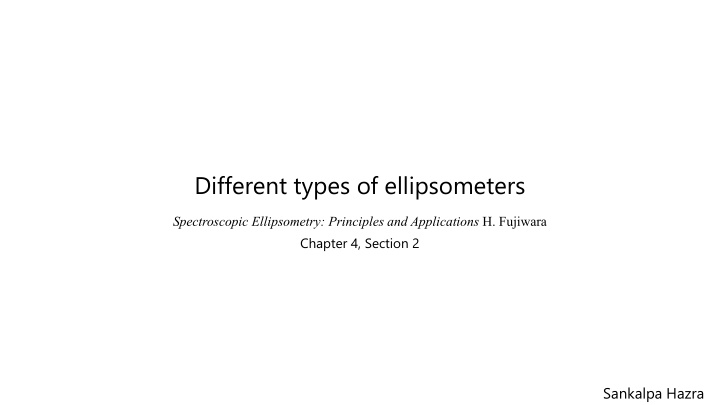
Understanding Ellipsometers: Principles, Applications, and Components
Discover the principles and applications of ellipsometers, including the measurement of Stokes parameters and the different components involved in the process. Explore various types of ellipsometers such as spectroscopic ellipsometry and phase modulation ellipsometry, each offering unique advantages for faster and more accurate measurements. Learn about the use of Fourier trick in finding Stokes parameters and how Mueller matrix ellipsometers are utilized for anisotropic samples.
Download Presentation

Please find below an Image/Link to download the presentation.
The content on the website is provided AS IS for your information and personal use only. It may not be sold, licensed, or shared on other websites without obtaining consent from the author. If you encounter any issues during the download, it is possible that the publisher has removed the file from their server.
You are allowed to download the files provided on this website for personal or commercial use, subject to the condition that they are used lawfully. All files are the property of their respective owners.
The content on the website is provided AS IS for your information and personal use only. It may not be sold, licensed, or shared on other websites without obtaining consent from the author.
E N D
Presentation Transcript
Different types of ellipsometers Spectroscopic Ellipsometry: Principles and Applications H. Fujiwara Chapter 4, Section 2 Sankalpa Hazra
What are we measuring? Ellipsometers measure s and p polarized reflected lights off the sample In Jones matrix representation, we aim to measure the Stokes parameters (Aim)
Typical ellipsometry components Measurement triggered by a rotating component
Rotating analyzer P: Polarizer A: Analyzer S: Sample R: Rotation matrix
Rotating analyzer with compensator
All Stokes parameters measured. Needs multiple measurements
Faster measurements
IR ellipsometry FTIR used in ellipsometer source
Michelson interferometer Rotating elements not feasible!
Mueller matrix ellipsometers For measuring anisotropic samples
Summary Ellipsometers use the Fourier trick to find out the Stokes parameters of the sample based on some moving optical elements. Different ellipsometers give different advantages: Inherited from Fujiwara.






















